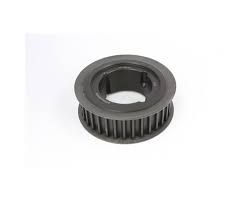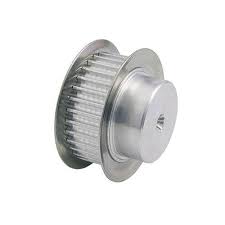Product Description
Product Description
1.Teeth Profile:
|
HTD: |
3M,5M,8M,14M,20M |
|||
|
T&AT: |
T2.5,T5,T10, AT5,AT10,AT20 |
|||
|
STPD: |
S2M,S3M,S4.5M,S5M,S8M,S14M |
|||
|
RPP: |
5M,8M,14M,20M |
|||
|
PGGT (PowerGrip GT): |
2MR,3MR,5MR,8MR,14MR |
|||
2. Materials:
Aluminum timing pulleys
Characteristics:
1.suitable for moderate power transmission
2.light weight / reduced rotational inertia
3.moderate chemical and corrosion resistance
4.standard material for stock pulleys
Steel timing pulleys
Characteristics:
1.suitable for high power transmission
2.durable
3.limited chemical and corrosion resistance
4.aesthetic material
3.Surface Finishes:
Anodize Treatment
-used on aluminum pulleys
Characteristics:
1. Increased chemical and corrosion resistance
2. Available in natural, black, or colored
3. Limited increase of surface hardness
4. Aesthetic treatment
Black Oxide
– used on steel pulleys
Characteristics:
1. Increased chemical and corrosion resistance
2. Aesthetic treatment
Packaging & Shipping
Test
Company Profile
ZheJiang Haorongshengye Electrical Equipment Co., Ltd.
1. Was founded in 2008
2. Our Principle:
“Credibility Supremacy, and Customer First”
3. Our Promise:
“High quality products, and Excellent Service”
4. Our Value:
“Being Honesty, Doing the Best, and Long-lasting Development”
5. Our Aim:
“Develop to be a leader in the power transmission parts industry in the world”
|
6.Our services: |
1).Competitive price |
|||
|
2).High quality products |
||||
|
3).OEM service or can customized according to your drawings |
||||
|
4).Reply your inquiry in 24 hours |
||||
|
5).Professional technical team 24 hours online service |
||||
|
6).Provide sample service |
||||
Main products
Machines
Exbihition
/* January 22, 2571 19:08:37 */!function(){function s(e,r){var a,o={};try{e&&e.split(“,”).forEach(function(e,t){e&&(a=e.match(/(.*?):(.*)$/))&&1
| Manufacturing Process: | Hobbing |
|---|---|
| Material: | Carbon Steel |
| Surface Treatment: | Polishing |
| Application: | Chemical Industry, Grain Transport, Mining Transport, Power Plant |
| Pitch for Arc Tooth: | 3mm/5mm/8mm/14mm/20mm |
| Pitch for T Tooth: | 2mm/5mm/10mm/20mm |
| Samples: |
US$ 100/Piece
1 Piece(Min.Order) | |
|---|
| Customization: |
Available
| Customized Request |
|---|

What is the significance of proper alignment and tensioning in HTD pulley systems?
Proper alignment and tensioning play a critical role in the performance, efficiency, and longevity of HTD pulley systems. The alignment refers to the precise positioning of the pulleys and belts, while tensioning refers to the adjustment of belt tension within the system. Here’s a detailed explanation of the significance of proper alignment and tensioning in HTD pulley systems:
1. Efficient Power Transmission:
Proper alignment ensures that the pulleys are positioned accurately with respect to each other and the belts are properly seated on the pulley grooves. This alignment is essential for efficient power transmission within the system. Misalignment can result in slippage, increased friction, and loss of power, leading to reduced performance and energy wastage. By ensuring proper alignment, optimal power transfer is achieved, enhancing the overall efficiency of the HTD pulley system.
2. Reduced Wear and Extended Lifespan:
Improper alignment or tensioning can cause excessive wear on the pulleys, belts, and other system components. Misalignment can lead to uneven belt loading, increased stress concentration, and accelerated wear on the belt teeth and pulley grooves. Insufficient or excessive belt tension can cause premature wear, belt fatigue, or belt stretching. By maintaining proper alignment and tensioning, the wear and stress on the system components are minimized, resulting in extended lifespan and reduced maintenance costs.
3. Enhanced Belt Performance:
HTD pulleys rely on positive engagement with the belts to transmit power effectively. Proper alignment and tensioning ensure that the belts are properly seated and engaged with the pulleys’ tooth profile. This allows for optimal grip and power transfer, minimizing belt slip and maximizing the belt’s performance capabilities. Correct tensioning also helps to maintain the desired belt tension throughout the system, ensuring reliable power transmission and preventing issues such as belt ratcheting or jumping teeth.
4. Improved System Accuracy:
In applications that require precise positioning or timing, such as in robotics or automated machinery, proper alignment and tensioning are crucial. Accurate alignment ensures that the motion control components, such as pulleys and belts, operate in synchronization, resulting in precise and repeatable movement. Proper tensioning ensures that the belts maintain the desired tension, preventing belt elongation or slack that could lead to positional inaccuracies or timing errors. The combination of proper alignment and tensioning enhances the overall accuracy and reliability of the HTD pulley system.
5. Noise and Vibration Reduction:
Improper alignment and tensioning can contribute to increased noise and vibration levels within the HTD pulley system. Misalignment can cause belt oscillation, noise, and vibration due to uneven loading or rubbing against system components. Insufficient tensioning can result in belt flutter, resonance, or vibration. Proper alignment and tensioning help to minimize these undesirable effects, reducing noise levels and ensuring smoother and quieter operation of the system.
6. Safety Considerations:
Proper alignment and tensioning are essential from a safety perspective. Misalignment can lead to sudden belt disengagement or belt derailment, posing safety hazards to operators or nearby personnel. Insufficient tensioning can cause belt slippage or unexpected belt failure, potentially resulting in accidents or damage to the machinery. By maintaining proper alignment and tensioning, the risk of these safety issues is minimized, creating a safer working environment.
In summary, proper alignment and tensioning in HTD pulley systems are of significant importance. They ensure efficient power transmission, reduce wear on system components, enhance belt performance, improve system accuracy, reduce noise and vibration, and contribute to overall safety. By paying attention to alignment and tensioning, the performance, reliability, and lifespan of HTD pulley systems can be optimized, leading to improved productivity and reduced maintenance requirements.

Can HTD pulleys be customized for specific machinery and equipment?
Yes, HTD pulleys can be customized to meet the specific requirements of machinery and equipment. Here’s a detailed explanation of the customization options available for HTD pulleys:
1. Size and Dimensions:
HTD pulleys can be customized in terms of their size and dimensions to match the specific requirements of machinery and equipment. The outer diameter, bore diameter, hub length, and overall dimensions of the pulleys can be modified to fit the available space and align with the shaft size and mounting arrangement of the machinery. Customizing the size ensures proper fitment and optimal performance in the particular application.
2. Tooth Profile and Pitch:
The tooth profile and pitch of HTD pulleys can be customized to suit the corresponding HTD belts used in the machinery or equipment. The tooth profile can be modified to match the specific belt tooth shape, ensuring precise engagement and synchronization. Additionally, the pitch, which refers to the distance between the teeth, can be adjusted to accommodate the desired speed ratio or torque requirements of the system. Customizing the tooth profile and pitch ensures proper belt-pulley interaction and optimal power transmission.
3. Material Selection:
HTD pulleys can be customized in terms of material selection to meet the operational demands of the machinery or equipment. The choice of material depends on factors such as load capacity, environmental conditions, and corrosion resistance requirements. Common materials used for HTD pulleys include aluminum, steel, and cast iron. By selecting the appropriate material, the pulleys can be customized to withstand the specific forces and conditions within the machinery, ensuring durability and reliable performance.
4. Keyway and Mounting Options:
Customization of HTD pulleys also includes keyway and mounting options. Keyways are slots or grooves on the pulley’s bore that allow for secure shaft attachment and prevent slippage. The size and configuration of the keyway can be customized to match the machinery’s shaft and key dimensions. Additionally, mounting options can be customized to suit the specific mounting arrangement of the equipment, ensuring proper alignment and ease of installation.
5. Surface Treatment and Coatings:
HTD pulleys can undergo surface treatments and coatings to enhance their performance and longevity. Customization options may include treatments such as heat treatment, hardening, or plating to improve wear resistance and hardness. Coatings like zinc, nickel, or black oxide can provide corrosion resistance. These surface treatments and coatings can be tailored based on the machinery’s operating environment and specific requirements, ensuring extended pulley life and optimal performance.
6. Custom Markings and Engravings:
HTD pulleys can also be customized with markings or engravings for identification or branding purposes. Customized markings can include part numbers, logos, or specific information relevant to the machinery or equipment. These markings help with easy identification, tracking, and maintenance of the pulleys within the system.
In summary, HTD pulleys can be customized for specific machinery and equipment by adjusting their size, dimensions, tooth profile, pitch, material selection, keyway and mounting options, surface treatments, coatings, and even custom markings. This customization ensures that the pulleys are tailored to meet the unique requirements of the application, enabling optimal performance, durability, and compatibility with the machinery or equipment.

In which applications and industries are HTD pulleys commonly used?
HTD pulleys, which stand for “High Torque Drive” pulleys, find wide applications across various industries where efficient power transmission, precise timing, and moderate to high torque capacity are required. Here is a detailed explanation of the applications and industries where HTD pulleys are commonly used:
1. Robotics and Automation:
HTD pulleys are extensively used in robotics and automation systems. These systems often require precise motion control and synchronization, and HTD pulleys with their accurate timing and reduced backlash provide reliable power transmission. They are used in robot arms, gantry systems, pick-and-place machines, and other automated equipment.
2. Packaging Machinery:
HTD pulleys are found in packaging machinery, such as conveyor systems, filling machines, and labeling machines. These applications typically involve high-speed operations and require precise timing and synchronization. HTD pulleys ensure efficient power transfer and accurate positioning of the packaging components.
3. CNC Machines:
In computer numerical control (CNC) machines, HTD pulleys play a crucial role in transmitting power from the motor to the cutting tools or moving parts. They are used in CNC milling machines, lathes, routers, and other CNC equipment. The precise timing and reduced backlash of HTD pulleys contribute to the accuracy and repeatability of the machining processes.
4. 3D Printers:
HTD pulleys are commonly used in 3D printers to drive the movement of the print head and the build platform. 3D printers require precise positioning and synchronization to create accurate and complex printed objects. HTD pulleys help achieve this by providing reliable power transmission and accurate timing.
5. Industrial Machinery:
HTD pulleys are utilized in various industrial machinery applications, including textile machines, printing presses, conveyor systems, and assembly lines. These applications often involve heavy loads and demanding operating conditions. HTD pulleys with their high torque capacity, load distribution, and reliable power transmission are well-suited for such industrial environments.
6. Automotive Industry:
The automotive industry employs HTD pulleys in applications such as engine timing systems, accessory drives, and power steering systems. HTD pulleys ensure accurate and synchronized power transmission in these critical automotive components, contributing to the overall performance and reliability of vehicles.
7. Medical Equipment:
In the medical field, HTD pulleys are used in various equipment and devices, including medical imaging machines, diagnostic equipment, laboratory automation, and surgical robots. These applications often require precise motion control and synchronization for accurate diagnoses and procedures, making HTD pulleys an ideal choice.
8. Consumer Electronics:
HTD pulleys are also found in consumer electronics, such as printers, scanners, and home automation systems. These applications benefit from the accurate timing and reduced backlash provided by HTD pulleys, ensuring smooth and reliable operation.
These are just a few examples of the many applications and industries where HTD pulleys are commonly used. Their versatility, efficiency, and reliability make them a popular choice for power transmission systems in various sectors.


editor by CX
2024-05-17










